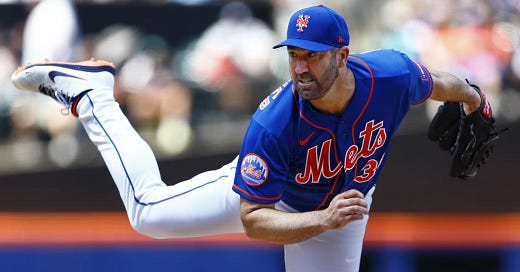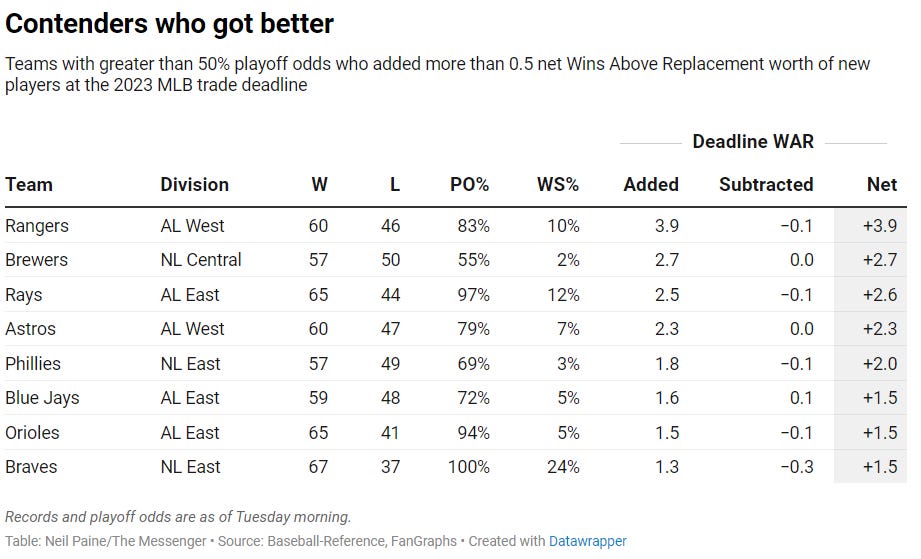Where Things Stand as the Dust Settles on MLB’s Trade Deadline
Who got better? Who didn’t do enough? We break down the biggest buyers, sellers and those teams who confusingly tried to do a bit of both.
Major League Baseball’s 2023 trade deadline has come and gone, and there were quite a few noteworthy moves — some of which didn't even include the Mets dismantling their $353 million roster.
To understand how the postseason landscape has changed, we’ve sorted teams into categories based on a combination of playoff odds (as of Tuesday morning) and the talent they netted, as measured by the Wins Above Replacement for players added to rosters minus those sent elsewhere.
Let’s start off with . . .
The Texas Rangers were already a prominent World Series contender before adding the most at the deadline. Texas loaded up on pitching in particular, acquiring Jordan Montgomery from the Cardinals and Max Scherzer from the Mets to bolster a staff that had ranked 18th in WAR this season.
Although they’ve only won 13 of their past 30 games, the Rangers identified (correctly) that they have a great chance of beating the Houston Astros for the AL West crown and securing the all-important first-round bye in the playoffs. Their deadline moves, which also included picking up reliever Chris Stratton and catcher Austin Hedges, should help in that endeavor.
Other contenders that added the most talent were on different trajectories approaching the trade deadline.
The Tampa Bay Rays have cooled considerably since their hot start, with a sub-.500 record since the start of June, but their playoff odds remain strong and they strengthened their rotation by adding Aaron Civale from Cleveland. Of course, so did their division rivals, the Baltimore Orioles, who picked up starter Jack Flaherty from the Cardinals to bolster a team that has won 18 of its past 30 games.
The Braves are in even stronger postseason positioning than either AL East frontrunner (their magic number for making the playoffs is just 40, the lowest of any team), but you can never have too much talent when chasing the World Series — and the addition of slick-fielding infielder Nicky Lopez could come in handy, even if he figures to be in a bench role.
The Houston Astros, Toronto Blue Jays and Philadelphia Phillies have lower playoff odds, but each made smart moves to add an impact player on Tuesday.
Houston got Justin Verlander back from the New York Mets, acquiring one of the best starters available at this year’s deadline. Toronto filled the absence of Bo Bichette, who went down with an injury on Monday, by snagging Paul DeJong from the Cardinals. And Philly added a reliable rotation member in Michael Lorenzen, who had a 3.58 ERA in Detroit.
Finally, the Milwaukee Brewers also fit in this category, having picked up outfielder Mark Canha, first baseman Carlos Santana and reliever Andrew Chafin to help in their NL Central dogfight against the Cincinnati Reds and Chicago Cubs. The new hitters can only help an offense that had ranked just 25th in batting WAR.
The Los Angeles Angels are an interesting counterpoint to their division rivals in Texas. L.A. was second to only the Rangers in terms of net WAR added at the deadline, and that does not include the huge impact of keeping Shohei Ohtani. But with just a 15% playoff probability, the Angels’ choice to buy instead of selling at the deadline still has a narrow path to success.
While the Rangers spent big last offseason on a risky team-building strategy that has largely paid dividends (despite injuries to stars such as pitcher Jacob deGrom), the Angels’ more subdued offseason looked smart on paper but it hasn’t been enough to augment Ohtani’s historic play. In that regard, this deadline surge felt like L.A. was playing catch-up with the additions of Lucas Giolito, Reynaldo López, Randal Grichuk and C.J. Cron — and it probably won’t matter in the end.
Regardless, this is undoubtedly a fascinating group of clubs. The Cubs switched from being presumed sellers to buyers when they went on their recent hot streak (they’ve won eight of 10 and 13 of 20), and their run differential makes them an intriguing team if they can sneak into the playoffs, even though that’s still unlikely at the moment.
The D-backs and Marlins made moves to try to reverse a pair of slides that have dipped their playoff odds below 50% after starting the season surprisingly strong. In picking up Jake Burger, who had 1.4 WAR for the White Sox, Miami added one of the better infielders available at the deadline. And Arizona made a good pickup in acquiring Tommy Pham from the Mets. (Although the D-backs also dealt away Chafin, trying to thread the needle between buyer and seller.)
The Red Sox show up in this category because they lost the negative WAR of Kiké Hernández (-1.0) as much as anything else, but they’re still just 2.5 games back in the wild-card race.
And then there are the San Diego Padres. This was a team pegged by many to contend for the World Series after adding Xander Bogaerts to a roster that had gone to the NLCS last season, but San Diego instead has been one of the most disappointing teams in MLB. And yet, instead of selling closer Josh Hader and others, the Padres were buyers — picking up Rich Hill and Ji Man Choi on Tuesday. Maybe general manager A.J. Preller felt he had no choice but to keep trying to turn the season around: He has doubled and tripled down on a win-now mindset so much that one presumes this team has never heard of the sunk cost fallacy.
Some teams with good playoff odds had more needs than others. Some felt comfortable staying the course without adding much for the stretch run.
A few solid-enough players were picked up in this group, including relievers Sam Moll (Reds) and Dylan Floro (Twins) and shortstop Amed Rosario (Dodgers). But it would have been nice to see a bit more firepower for the most precarious teams on this list — I’m looking at the Reds and Giants in particular — as well as for the teams with glaring flaws. (The Giants, Reds, Dodgers and Twins all rank among the bottom 10 in WAR from at least one position this season.)
Maybe the funniest entry in this group is the Los Angeles Dodgers, highlighting the oddities that can arise when ranking by in-season WAR.
Los Angeles definitely made headline additions at the deadline, picking up Rosario, Joe Kelly, Lance Lynn and Hernández. So why don’t they rank higher in our accounting? Because three of those four have negative WAR this season, and Rosario (0.1) isn’t far off. If those additions play more to their historical track records, the Dodgers’ deadline moves could end up looking better by season’s end — although they’ll still probably regret not being able to add coveted lefty starter Eduardo Rodriguez because he invoked his no-trade clause.
Being wishy-washy is one of the worst things a team can do at the deadline. You can’t be unsure about your buyer or seller status. These two clubs were guilty of that indecision, neither adding nor subtracting much of note despite playoff odds that mostly screamed, “Sell!”
In both cases, the Yankees and Mariners had big postseason aspirations entering the season and still seem to be hanging on to those hopes in the face of a tough numbers game in the divisional and wild-card races. But neither has even a 20% chance to make the playoffs, and the biggest name either team picked up was reliever Kenyan Middleton, who takes his 0.2 WAR this season to New York. Maybe the choice to stay in the fight without adding reinforcements will end up working out — but generally, if a group hasn’t been playoff-worthy by this point in the season, it probably won’t be.
Finally, that leaves us with the group of teams that has clearly packed it in for next season and perhaps even beyond. Many of these teams wouldn’t have been especially surprising from before the season, but the White Sox, Cardinals and Mets stand out for turning what seemed like promising clubs into fire-sale fodder with breakneck speed.
(In fact, the Mets’ massive midseason fire sale might make this deadline go down as one of the most notable ever for a franchise that is no stranger to embarrassing failures.)
The Cleveland Guardians are perhaps the most interesting entry here. Despite playoff odds (26%) that would have inspired other teams on our other lists to buy, they shipped away Civale and Rosario — the latter being notable because he hit well (106 OPS+) last season and Cleveland needs offense — while adding only the well-past-their-primes Noah Syndergaard (-0.3 WAR) and Jean Segura (-1.4).
Cleveland is one game behind in the painfully mediocre AL Central race, but instead of seizing on that opportunity, the Guardians made moves that downgraded their talent for the rest of the season.
Filed under: Baseball










